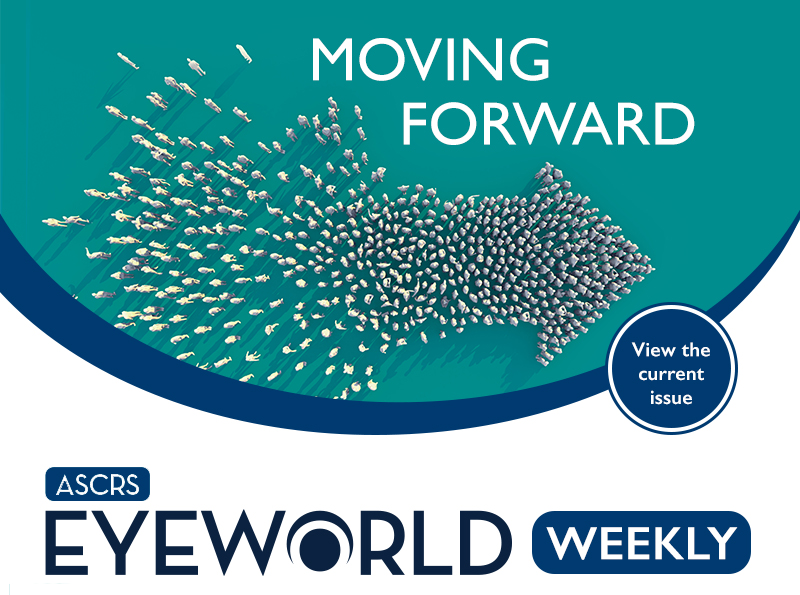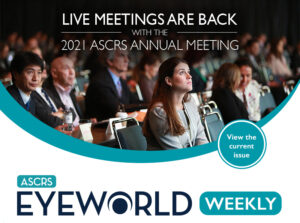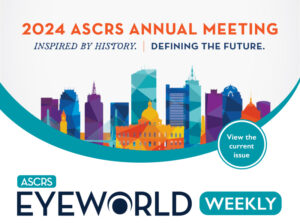
- Commercial launch of Alcon’s Vivity IOL
- Topline results from Phase 2 trial for treatment of contact lens discomfort
- Company registers new artificial intelligence visual field exam device with FDA
- Positive Phase 3 results for faricimab for DME
- Research begins to create a MIGS patient-reported outcomes instrument
- ASCRS events
January 8, 2021 • Volume 27, Number 1
Commercial launch of Alcon’s Vivity IOL
This week, Alcon announced the commercial launch of its new Vivity IOL, now available to all U.S. ophthalmologists. This IOL is described as a first-of-its-kind, non-diffractive EDOF IOL that provides an extended range of vision without increasing incidence of visual disturbances. According to the company, the IOL uses X-WAVE technology that “stretches and shifts light without splitting it.”
Topline results from Phase 2 trial for treatment of contact lens discomfort
Azura Ophthalmics announced positive topline results that met primary endpoints in its Phase 2 trial of an investigational treatment for contact lens discomfort. According to the company’s press release, AZR-MD-001 applied twice weekly significantly improved meibomian gland secretion and improved patients’ ability to wear contact lenses compared to the vehicle. Azura said that the therapy uses selenium disulfide to address abnormal hyperkeratinization at the meibomian glands.
Company registers new artificial intelligence visual field exam device with FDA
Heru, a company originating out of Bascom Palmer Eye Institute, University of Miami, registered new technology with the FDA for vision diagnostics and augmentation. According to the company’s press release, this class 1 listing is for a device that is cloud-based and uses virtual reality for visual field exams. The company stated that the technology could be used virtually or in person for the diagnosis of vision defects with customized visual augmentation based on a patient’s unique defects.
Positive Phase 3 results for faricimab for DME
Genentech announced positive Phase 2 results for faricimab as a treatment for patients with DME. According to the company’s press release, faricimab, given every 8 weeks and at a personalized dosing interval up to 16 weeks, showed noninferiority to aflibercept in the YOSEMITE and RHINE trials. Those in the personalized dosing interval group saw extended time between treatments to 16 weeks at 1 year, which the press release stated is the first time this level of durability has been seen in a Phase 3 DME study. Faricimab uses a bispecific antibody that targets angiopoietin-2 and VEGF-A. If approved, the company said that it would be the first treatment with a new mechanism of action to come out for DME in nearly a decade.
Research begins to create a MIGS patient-reported outcomes instrument
Verana Health announced its collaboration with the FDA, UCSF, Stanford University, the American Academy of Ophthalmology, and the American Glaucoma Society to develop a patient-reported outcomes instrument for MIGS, which the company’s news release explained could be used for FDA submissions of MIGS devices and to answer quality of life-related questions. The study to create the Glaucoma Outcomes Survey has enrolled its first patient and will enroll up to 500 patients with the survey being taken by patients before and after their MIGS procedure. AAO’s IRIS Registry and Verana Health data are being used to identify potential study sites, and Verana Trial Connect software will be used to help identify potentially eligible candidates and support efficient enrollment, the company’s press release said.
ASCRS events
- Join the interactive ASCRS Journal Club on Thursday, January 14, from 9:00–10:00 p.m. ET for another exciting session in a monthly series in which a panel of experts discuss two pre-selected manuscripts from the Journal of Cataract & Refractive Surgery. Nick Mamalis, MD, and Leela Raju, MD, co-moderate these free CME sessions, open to all ASCRS members. The January session will feature Michael Belin, MD, and Jennifer Nadelmann, MD, as discussants, and Clara Chan, MD, B.J. Dupps, MD, and Doug Koch, MD, as panelists.
- ASCRS Foundation Operation Sight grant applications open January 8 and close January 25.
Research highlights
- Secondary analysis of the randomized Infant Aphakia Treatment Study looked at the 10-year incidence of glaucoma and glaucoma suspect that occurred after cataract surgery at 1–6 months old. The research found that risk of glaucoma in this population after 10 years was 22% higher (glaucoma suspect was 40% higher). There was no difference in these percentages if the patient was left aphakic or received a primary IOL. Glaucoma development was not associated with worsened visual acuity at 10 years postop, however. These findings, the authors concluded, show that risk of glaucoma increases with longer follow-up after infant cataract surgery, emphasizing the importance of long-term surveillance of these patients. The study is published in JAMA Ophthalmology.
- Residual refractive error and complication rates of eyes that had a manual capsulotomy vs. a precision pulse capsulotomy with an automated device were compared in a paper published in Clinical Ophthalmology. The study included 243 eyes (122 that had a precision pulse capsulotomy and 121 manual). Most patients (75%) had a trifocal IOL implanted. The researchers observed no statistically significant difference in MRSE based on IOL type or overall. There was a significantly higher percentage of eyes that had residual refractive cylinder in the precision pulse capsulotomy group (89%) vs. controls (79%). Capsulotomy-related complications were also lower in the precision pulse group (4.1% compared to 6.6% in the manual group), though this was not statistically significant.
- An artificial intelligence-supported test helped detect wet AMD up to 3 years before visual symptoms, according to research published in Expert Review of Molecular Diagnostics. A press release about the research explained that the test (Detection of Apoptosing Retinal Cells, DARC) involves a fluorescent dye, injected into the bloodstream, that attaches to retinal cells and shows which ones are in stress or undergoing apoptosis. The more cells like these that are detected, the higher the “DARC count.” The study looked at 19 patients who had AMD in one eye but not the other. According to the press release, researchers developed and trained an artificial intelligence program to detect leaking and new blood vessels that corresponded to the cells detected by the DARC test. It further stated that the test can find stressed endothelial cells lining blood vessels in the retina, and it is these cells that the researchers say can predict wet AMD.
Product news
- Norlase received the CE mark for its LION laser indirect ophthalmoscope, which features an untethered, portable design that can be moved between treatment rooms.
- Ocular Therapeutix submitted a supplemental new drug application (NDA) to the FDA for Dextenza (dexamethasone ophthalmic insert) for ocular itching associated with allergic conjunctivitis.
- Eyenovia submitted an NDA to the FDA for MydCombi, a fixed combination mydriatic agent.
- VisionQuest Biomedical received FDA 510(k) clearance for its Image Quality Analyzer software, which the company stated reduces unreadable images captured for teleretinal screening programs.
This issue of EyeWorld Weekly was edited by Stacy Jablonski and Liz Hillman.
EyeWorld Weekly (ISSN 1089-0319), a digital publication of the American Society of Cataract and Refractive Surgery (ASCRS), is published every Friday, distributed by email, and posted live on Friday.
Medical Editors: Eric Donnenfeld, MD, Chief Medical Editor; Rosa Braga-Mele, MD, Cataract Editor; Clara Chan, MD, Cornea Editor; Nathan Radcliffe, MD, Glaucoma Editor; and Vance Thompson, MD, Refractive Editor
For sponsorship opportunities or membership information, contact: ASCRS • 12587 Fair Lakes Circle • Suite 348 • Fairfax, VA 22033 • Phone: 703-591-2220 • Fax: 703-591-0614 • Email: ascrs@ascrs.org
Mention of products or services in EyeWorld Weekly does not constitute an endorsement by ASCRS.
Click here to view our Legal Notice.
Copyright 2021, EyeWorld News Service, a division of ASCRSMedia. All rights reserved.



